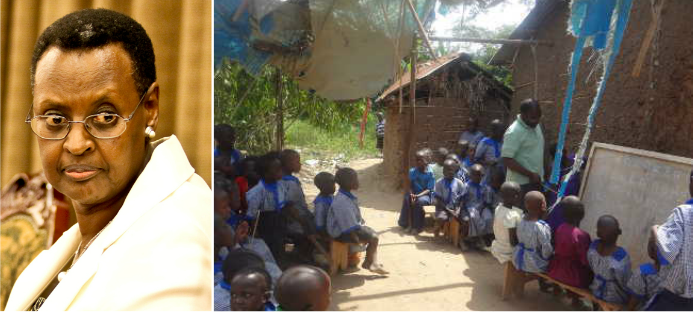Despite nationwide cries to reverse the trend of Busoga being the worst performing region in the Primary Leaving Examinations in the country, the government has not heeded as the Education ministry rolls out a multi-billion three-year development project.
Over the year’s, the worst performing districts in PLE were mostly from Busoga and the wider eastern region.They include Buyende followed by Luuka, Kween, Mayuge, Kaliro, Iganga , Kyankwazi, Bulambuli, Namutumba and Serere.
In 2013, Busoga region recorded 15,851 pupils in Division U or Ungraded which means that they failed. This represents 23 percent of the total number of ungraded pupils – the highest number of failures in the country.
The region was also disappointing when it came to first grades. It recorded a miserable 3900 in Division one representing just 6.3% of the total number of students who passed with first grades countrywide.
The following three years, Luuka and Namayingo districts have registered the lowest PLE pass rates in the country that in January 2017, First Lady and Education minister Janet Museveni flanked by UNEB executive secretary Daniel Odongo and board chairperson Prof. Mary Okwakol announced how Namutamba district led the pack of failures with only just 24.3 of their candidates passing, while Bulambuli had a 74.3% failure rate. Others like Buyende, Iganga and Mayuge districts had more than three-quarters of their candidates failing in the last PLE.
While the Ms. Janet Museveni blames this poor performance to the high rate of absenteeism for both teachers and pupils.
The juicy project
It was the least expected when the announcement of construction of the 92 schools in 28 districts as part of a $100m (Shs354b) grant provided by the Global Partnership for Education (GPE), one of the world’s largest basic education donors, strangely, Busoga region which desperately needs the help in the education sector through the Uganda Teacher and School Effectiveness Project (UTSEP) under supervision of the World Back basically got crumbs.
Dr Daniel Nkaada, the project coordinator and commissioner for pre-primary and primary education , said the beneficiaries of both Lot 1&2 were schools in Ibanda, Butaleja, Butambala, Kabale, Kagadi, Kamwengye, Kibaale, Kiruhura, Kyankwanzi, Lwengo, Lyantonde, Manafwa, Mbarara, Mitooma, Mityana, Mubende, Mukono, Nakaseke, Nebbi, Ntungamo, Oyam, Rakai, Rubanda, Rukungiri, Sheema, Tororo, Wakiso and Namutumba being the only beneficiary from Busoga.
Each beneficiary will have a permanent, furnished classroom (P1-P7), two gender and disability friendly five-stance pit latrines, a safe water source (5,000-litre tank), and administration block and two housing units for teachers.
The education ministry last week called for submission of bids under National Competitive Bidding for the provision of civil works for 55 (more than half) of the new schools and the deadline is on 6th, April 2017.

Whatever reason that might have motivated this imbalance in resource allocation, Mr Joseph Ngobi, a senior communications officer at Ministry of Education and Sports and also the UTSEP project spokesperson, believes it is not justifiable enough to say that the imbalance is ‘political’ considering the fact that the region has enjoyed political stability and all-round development since President Yoweri Museveni came to power in 1986.
“It is not correct to call UTSEP political in any way. As the ministry and our strategic partners, we did an assessment and Busoga region performed poorly overall,” Mr. Ngobi told TheUgandan via a telephone interview.
When pressed harder for an insight into the assessment employed to pick which districts and regions get to benefit from the project, Mr Ngobi said that he was not the right person to disclose such information to the media but gave an insight of how the schools considered were required to show proof of a school improvement plan, records of management meetings, availability of teachers on site and the level of interest of parents in their children’s education among others.
Understanding Busoga schools’ problems
Today in Busoga, you can only find a few of such among the rural schools and Luuka District education officer, Mr Moses Galandi, said one of the main causes of the poor performance was absenteeism of both teachers and pupils.
“Over the years, the performance in Luuka District has kept declining. In 2015, we got 150 first grades and in 2016 we had 144, this year it could drop further. This is because most pupils prefer to work in the sugar cane field instead of being in class,” Mr Galandi said and thus by far, the Uganda Teacher and School Effectiveness Project (UTSEP) would have significantly helped guarantee Busoga region better learning outcomes.

While the imbalance at the moment can only be taken with a pinch (a very big one) of salt , the GPE program is expected to provide training to 20,000 primary school teachers to enable them to improve the teaching of early grade reading and math for one million children. The program will reach eight million students with new textbooks and support the construction of new classrooms and improve school facilities in 293 schools. Hopefully, Ministry of Education and Sports will then heed to the agitation for the improving efficiency in Busoga’s education sector.
ALSO READ: Technocrats are failing me; Janet Museveni cries out
RELATED CONTENT: Ms. MusevenI’s ministry hit by Shs14 billion scandal, spent Shs168M on one teacher in single day
READ MORE: Min. Janet Museveni aides embroiled in Shs3.4bn UPE scam











